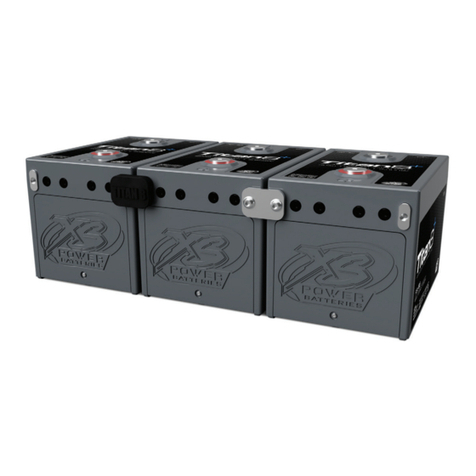
PN 41-T8BCI-INS
Titan8 BCI Series Instructions
Proper Charging is Crucial!
Charge before initial use!
Be sure to read the Instruction Sheet for full instructions.
Do Not Over-tighten Battery Terminals!
Proper Charging is crucial to the life of your XS Power TITAN8 battery. It is very important
that the temperature of the battery remains cool with respect to the charge voltage.
TEMPERATURE SPECIFICATIONS
Nominal Operating Temp.
Recommended Operating Temp.
Storage Temp. Range
-4
0
F - 131
0
F (-20
0
C - 55
0
C)
14
0
F - 95
0
F (-10
0
C - 35
0
C)
5
0
F - 122
0
F (-15
0
C - 50
0
C)
PROP 65 WARNING: This product can expose you to chemicals includinglead
and lead compounds, which are known to the State of California to cause
cancer or birth defects or other reproductive harm. Wash hands after handling.
For more information, visit www.P65Warnings.ca.gov
READ the battery label and do not exceed any of the ratings.
Do not over discharge this battery. Terminal voltage should at all times remain
above 9V(12V models), 10.8V(14V models) or 12.5V(16V models).
Disconnect when not in use.
Make sure you have the correct charger. Lithium batteries are voltage sensitive so
pay close attention to the max voltage rating.
Do not use an undersized battery for the job esp. in applications under -20oC(-4oF).
If the terminal voltage under-load drops below 9V(12V Models), 10.8V(14V Models) or
12.6V(16V Models) the battery is too small for the job. Stop and resolve the issue before continuing.
Pulse loads by their very nature are a pseudo short circuit of the battery. This is fundamen-
tally destructive to the battery so each battery’s State of Health should be regularly checked.
See the separate SDS sheets for additional information at, https://www.4xspow-
er.com/support/material-safety-data
Congratulations on your purchase of an XS Power Batteries lithium TITAN8 battery.
You have in your hand the cutting edge lithium battery made for extreme power or
extreme reserve applications.
Lithium cells hold, in general terms, three times the energy density of lead acid
batteries. However they need careful management to be safe and provide a long
service life. Fundamentally, they have serious risks associated with them and
these must be understood to avoid danger, loss of property, and personal injury.
Lithium batteries are not lead acid batteries. That seems to be stating the obvious
but for the majority of the people reading this instruction sheet, it is a significant
one. You are probably replacing a lead acid (flooded, maintenance free, or AGM)
battery with this new lithium battery. To get the most out of your new battery,
specific care and procedures are required. Read this sheet carefully so that you
fully understand what your new lithium battery can and cannot do.
Introduction
The Quick List
Technical Assistance
Our Customer Service Department is eager to help you with any questions or
issues you may have and are available from 8:30AM to 5:30PM, Monday thru
Friday at 865-688-5953. In addition, technical support is available via FAX at
our website for additional technical and product information.
You may mount the Lithium battery in any direction as long as it is secured from
short circuits and/or movement. One word of caution though. This battery is very
light and therefore it does not require a great deal of force to hold it. Do not crush
the battery with battery retention systems. The threads are M6-1.0. Optional
mounting kits and terminals are available. Observe the maximum torque ratings on
the battery label.
Be extremely careful when making connections. Remember there is no low
voltage disconnect, reverse polarity, or short circuit protection on the main
terminals of this battery. Further the power output of a lithium battery is four times
that of typical lead acid batteries. Short circuits will flow huge amounts of current
instantly with the ability to melt metal.
Do not expose to temperatures above 60oC (140oF). Elevated temperatures
accelerate the aging process of most battery types and lithium batteries are
especially sensitive to high temperatures. If it must be in the engine compar tment,
use a heat shield and duct cool air around the battery.
Parallel connection of this lithium battery is not recommended. By its very nature
this connection method cannot be considered 100% safe. If parallel connection is
unavoidable, fuses, switches, or fusible links must be used to control excessive cross
current (current flowing from one battery to the adjacent battery.)
Open circuit voltage should be 12.8V for 12V, 15.4V for 14V, and 17.8V for 16V
when fully charged after resting for 8 hours. If it is less than this after resting for 8
hours, the battery should be taken out of service and must be checked for capaci-
ty, cell balance, and State of Health before resuming operation.
Installation
Charging
Typically the battery will ship at less than 100% State of Charge (SOC.) Please
charge your new battery immediately upon receipt. It is important that you use a
lithium capable charger your battery, and one that is rated for the correct voltage.
Lithium batteries are by their very nature voltage sensitive. Further, the lithium
battery is the most vulnerable to damage while charging. It is important that the
charging process of the battery be fully understood and carefully controlled.
DO NOT use a battery charger designed for “Flooded” or “Maintenance Free” batteries
DO NOT use a battery charger with a “de-sulfation mode” or “float mode”.
Remove the battery charger once the battery is full meaning 100% State of Charge.
Unlike lead acid batteries, over charging lithium batteries DOES NOT help them nor
cause them to store more power. Instead it harms them and should be strictly avoided.





















